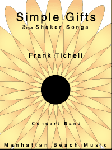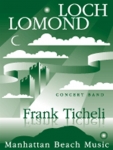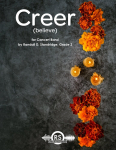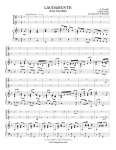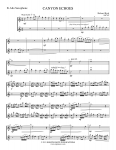Shop Auswahl
Unterkategorien
Kategorien
Willkommen zurück!
Komponist:
Ticheli, Frank Besetzung:
Blasorchester
Produktart:
Partitur Erscheinungsjahr:
2002 HISTORICAL BACKGROUND
At the time in Scottish history when "Loch Lomond" was a new song, the United Kingdom (which united Scotland, England, and Wales) had already been formed. But the Highland Scots wanted a Scottish, not an English King to rule. Led by their Bonnie Prince Charlie (Prince Charles Edward Stuart) they attempted unsuccessfully to depose Britain's King George II. An army of 7,000 Highlanders were defeated on April 16, 1746 at the famous Battle of Culloden Moor.
It is this same battle that indirectly gives rise to this beautiful song. After the battle, many Scottish soldiers were imprisoned within England's Carlisle Castle, near the border of Scotland. "Loch Lomond" tells the story of two Scottish soldiers who were so imprisoned. One of them was to be executed, while the other was to be set free. According to Celtic legend if someone dies in a foreign land, his spirit will travel to his homeland by "the low road" - the route for the souls of the dead. In the song, the spirit of the dead soldier shall arrive first, while the living soldier will take the "high road" over the mountains, to arrive afterwards.
The song is from the point of view of the soldier who will be executed: When he sings, "ye'll tak' the high road and I'll tak' the low road" in effect he is saying that you will return alive, and I will return in spirit. He remembers his happy past, "By yon bonnie banks ... where me and my true love were ever wont to gae [accustomed to go]" and sadly accepts his death "the broken heart it ken nae [knows no] second Spring again."
The original folksong uses a six note scale; the seventh scale degree is absent from the melody. The lyric intertwines the sadness of the soldier's plight with images of Loch Lomond's stunning natural beauty.
ABOUT MY SETTING
In my setting, I have tried to preserve the folksong's simple charm, while also suggesting a sense of hope, and the resilience of the human spirit. The final statement combines the Scottish tune with the well-known Irish folksong, "Danny Boy." It was by happy accident that I discovered how well these two beloved songs share each other's company, and I hope their intermingling suggests a spirit of human harmony.
Loch Lomond was commissioned by Nigel Durno, for the Stewarton Academy Senior Wind Ensemble of East Ayrshire, Scotland, with funds provided by the Scottish Arts Council. The premiere performance was given on June 18, 2002 by the Stewarton Academy Senior Wind Ensemble at Royal Concert Hall in Glasgow, Scotland.
At the time in Scottish history when "Loch Lomond" was a new song, the United Kingdom (which united Scotland, England, and Wales) had already been formed. But the Highland Scots wanted a Scottish, not an English King to rule. Led by their Bonnie Prince Charlie (Prince Charles Edward Stuart) they attempted unsuccessfully to depose Britain's King George II. An army of 7,000 Highlanders were defeated on April 16, 1746 at the famous Battle of Culloden Moor.
It is this same battle that indirectly gives rise to this beautiful song. After the battle, many Scottish soldiers were imprisoned within England's Carlisle Castle, near the border of Scotland. "Loch Lomond" tells the story of two Scottish soldiers who were so imprisoned. One of them was to be executed, while the other was to be set free. According to Celtic legend if someone dies in a foreign land, his spirit will travel to his homeland by "the low road" - the route for the souls of the dead. In the song, the spirit of the dead soldier shall arrive first, while the living soldier will take the "high road" over the mountains, to arrive afterwards.
The song is from the point of view of the soldier who will be executed: When he sings, "ye'll tak' the high road and I'll tak' the low road" in effect he is saying that you will return alive, and I will return in spirit. He remembers his happy past, "By yon bonnie banks ... where me and my true love were ever wont to gae [accustomed to go]" and sadly accepts his death "the broken heart it ken nae [knows no] second Spring again."
The original folksong uses a six note scale; the seventh scale degree is absent from the melody. The lyric intertwines the sadness of the soldier's plight with images of Loch Lomond's stunning natural beauty.
ABOUT MY SETTING
In my setting, I have tried to preserve the folksong's simple charm, while also suggesting a sense of hope, and the resilience of the human spirit. The final statement combines the Scottish tune with the well-known Irish folksong, "Danny Boy." It was by happy accident that I discovered how well these two beloved songs share each other's company, and I hope their intermingling suggests a spirit of human harmony.
Loch Lomond was commissioned by Nigel Durno, for the Stewarton Academy Senior Wind Ensemble of East Ayrshire, Scotland, with funds provided by the Scottish Arts Council. The premiere performance was given on June 18, 2002 by the Stewarton Academy Senior Wind Ensemble at Royal Concert Hall in Glasgow, Scotland.
Folgende Optionen können gewählt werden um diese Ausgabe zu konfigurieren:

